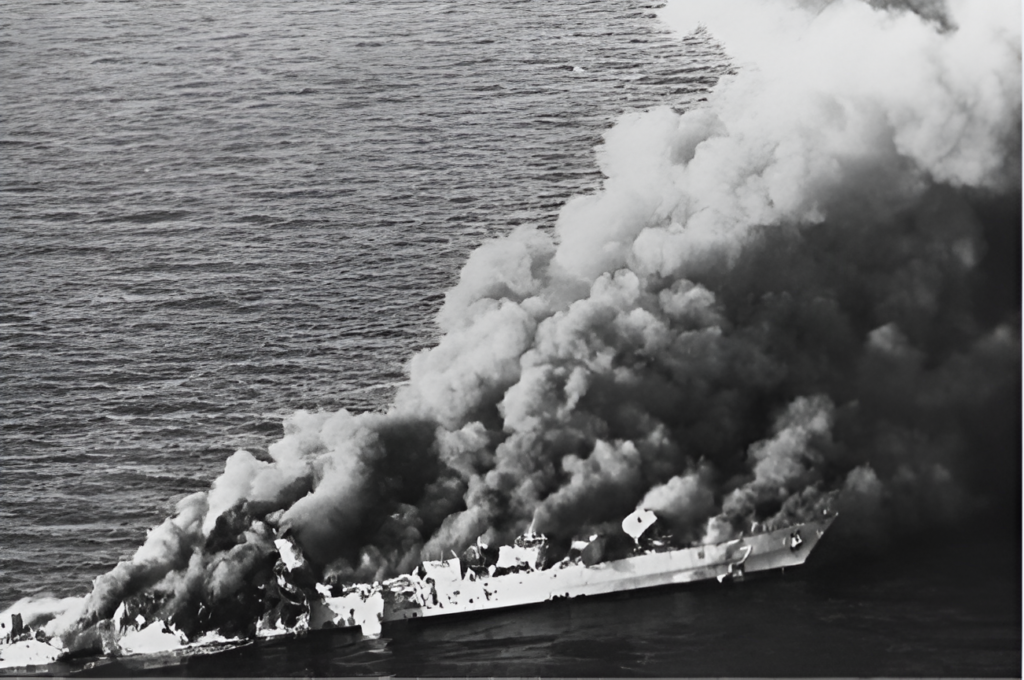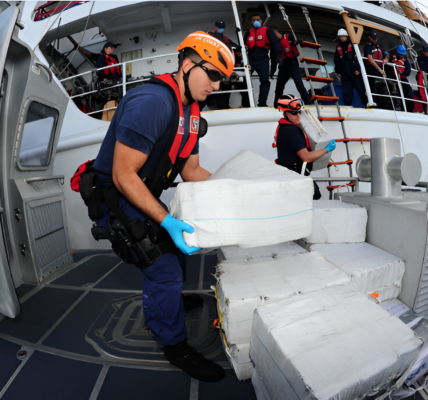
In the inky darkness of the Persian Gulf, a flight of three U.S. Army special operations helicopters, known as MH-6 “Little Birds,” encountered a small Iranian freighter. These nimble helicopters, renowned for their agility, were armed with rocket pods and carried pilots prepared to engage with small arms if necessary. On this particular night, the freighter’s crew extinguished its deck lights, a suspicious act that allowed the helicopter crew to observe the vessel using night vision. What they saw raised alarm: the crew hastily pushed what appeared to be metal cylinders over the side and into the ocean.
“They’re pushing those … shopping carts … over the side now,” one of the pilots radioed back to the command center on a U.S. Navy ship miles away.
The ship’s combat information center, unusually busy for nighttime operations, received the report. Rear Adm. Harold “Hal” Bernsen, commander of the U.S. Middle East Force, turned to Lieutenant Mark Helmkamp, a specialist in mine warfare, and asked, “What do you think they are doing?” Helmkamp’s analysis was swift: “Sir, I think they are laying mines.”
Bernsen’s response was immediate: “Take them!”
The Little Birds received the green light to engage and began their attack runs, firing rockets into the freighter’s deck, bridge, and engine room. The admiral’s decisive order was not made lightly. Intelligence gathered earlier in the evening had suggested increased Iranian activity, and U.S. rules of engagement permitted kinetic responses to Iranian mine-laying operations—considered acts of war. This encounter wasn’t part of Operation Prosperity Guardian, the recent U.S.-led mission to secure the Red Sea and Gulf of Aden. Instead, it was an incident from Operation Earnest Will, a 1987 mission to protect commercial shipping in the Persian Gulf during the Iran-Iraq War. Revisiting this history reveals valuable lessons for today’s maritime operations in the Red Sea and beyond.
Parallels Across Decades
The 1980s saw the Persian Gulf become a critical theater as the Iran-Iraq War spilled into the maritime domain. At the time, the Strait of Hormuz served as the lifeline for 60% of the world’s oil trade. The war’s impact on global energy markets and shipping insurance rates made U.S. intervention inevitable.
Iraq’s strategy targeted Iran’s oil trade with air-to-surface missile attacks, often conducted by aircraft flying over Saudi and Kuwaiti territory. Conversely, Iran’s tactics included covertly mining Kuwaiti ports and targeting vessels with Silkworm surface-to-surface missiles. The United States, though not directly reliant on Middle Eastern oil, recognized the need to protect global allies like Japan from disruptions to their energy supplies.
In January 1987, Kuwait proposed a bold deterrence strategy: reflagging its tankers under the American flag to secure U.S. Navy protection. By March, President Ronald Reagan’s administration approved the plan, leading to Operation Earnest Will—a significant naval commitment under Rear Adm. Bernsen. The mission involved traditional convoy escort operations, with U.S. warships shepherding reflagged tankers through the Persian Gulf.
The First Convoy and Its Wake-Up Call
The first convoy of Operation Earnest Will set sail on July 22, 1987, with two tankers and three warships. On July 24, the convoy’s lead ship, MV Bridgeton, struck an Iranian mine, tearing a 50-square-meter hole in its hull. Though the vessel remained afloat and there were no casualties, the incident highlighted the Iranian willingness to challenge U.S. naval power and target any flagged ship.
This incident underscored the need for mine-clearance operations and more robust convoy protocols. It also set the stage for heightened U.S. engagement in the region, including the September 21 encounter with the Iran Ajr freighter, where U.S. special operations helicopters intervened to prevent further mine-laying.
Lessons for Modern Operations
The parallels between Operation Earnest Will and current maritime security efforts, such as Prosperity Guardian, are striking. Both missions underscore the strategic importance of protecting vital shipping lanes, whether in the Red Sea or the Persian Gulf. Both highlight the challenges of countering asymmetric threats, such as mines and small patrol craft, in constrained waterways.
However, while history doesn’t repeat itself, it often rhymes. The Tanker War demonstrated the difficulty of achieving total deterrence. Despite U.S. naval presence, attacks on shipping continued. Similarly, today’s efforts to ensure freedom of navigation in the Red Sea face persistent threats from state and non-state actors. The lessons of Earnest Will—the need for clear rules of engagement, rapid response capabilities, and effective coordination with allies—remain just as relevant.
Understanding the history of the Tanker War not only informs current maritime strategy but also serves as a reminder of the enduring importance of safeguarding global trade routes. Whether in the Strait of Hormuz or the Bab al-Mandeb, the stakes are as high now as they were in the 1980s.


